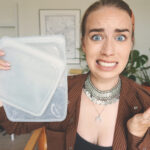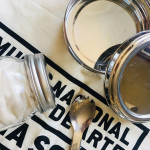The Impact of Silicone // and is it better than plastic?
The material we are going to talk about today is silicone. This was highly requested and with good reason. More and more eco shops and brands are promoting and selling silicone products as a replacement for plastic products and that’s got a lot of consumers wondering. What is the difference exactly? Isn’t silicone plastic? Is it actually more sustainable, and if so, then how? As always you can find the sources in the description and head over to my blog to get the scrips for these videos if you want to read it instead. I created this “Is It Sustainable” series to give you guys a better overview of the different materials and products that are available to us in our daily lives, and to give you the best possible overview so you can make informed decisions yourself. So without further ado, this is the tea on silicone.

Production:
Silicone is normally described as belonging to the rubber family pure, natural rubber is more commonly recognized as latex which naturally is derived from the rubber tree. These trees were first discovered in South America. With this natural material as a starting point, anything which is not formed from this rubber is a synthetic aka man-made and not naturally occurring. Silicone is a synthetic, but synthetic by itself is not necessarily a bad thing, it just means that it doesn’t grow on trees. Synthetics are made by mixing various materials together, then it becomes a synthetic polymer, “poly” meaning many aka mixed, which is why most plastic has a name that starts with “poly”. A polymer can be many things and the most common description is “a substance consisting of very large molecules, or macromolecules, composed of many repeating subunits”. If the polymer has elastic properties, so if it is bendy and stretchy, it is called an elastomer. Silicone is a synthetic elastomer. Because one of the silicone’s main qualities is that it is more bendable than plastic.

Silicone itself is made up of carbon, hydrogen, oxygen, and silicon. Note that the ingredient contained within silicone is spelled differently. Silicon — with no “e” — is a chemical element, also present on the periodic table. The ingredient silicon comes from silica which is derived from sand. The sand that is used to make silicone is actually just normal beach sand. If you remember the video about glass, we talked about how the minerals required to make glass also came from sand, however a very particular type of sand. In contrast, silica is a much more abundant mineral, however still not an infinite resource and producing intense amounts could potentially cause a problem for decreasing coastlines and natural environments.
Anyway, isolating silicon from silica is the first step in the production of silicone. This is done by heating a large volume of quartz sand to temperatures as high as 1800˚C. This results in pure, isolated silicon. Again, as was the case with glass production, whenever really high temperatures are required during a production it usually comes with lots of fossil fuels as well as high carbon emissions. And in order to make silicone, you actually have to process the materials through high-temperature furnaces several times. When making silicone, the extracted silicon has to pass through some hydrocarbons and afterward, it is mixed with other chemical compounds, some of these are derived from fossil materials aka plastic. Because silicone is a synthetic polymer, it is not biodegradable btw, just wanted to make that clear as well.

Is it better than plastic?
In sustainability, communities silicone is often seen as a more sustainable alternative to normal plastic because fewer fossil fuels are added and it is made from sand. I do wish however that we would see some more transparency when it comes to the cons of silicone like the high melting temperatures or the fossil additives used. But, one of the reasons why silicone is considered to be a good alternative to plastic is because it doesn’t contain the harmful chemicals that plastic does. Like phthalates and BPA. When plastic is exposed to heat, even small low-cooking temperatures, even storing warm food in a plastic container, these chemicals will react and affect your body. Studies show that especially children are exposed to lots of these effects which can be hormone disruptions and cancers.
To this, I would like to add that cheaply made silicone actually can be mixed with dangerous chemicals as fillers to make the material heat resistant. Therefore, you should always go for food-grade or medical-grade silicone, especially if you are heating it, or using it with food items. So cheaply made silicone can have some of the same effects as plastic. You can test the quality of a silicone product by twisting or pinching it. If the silicone starts to change color, then it contains chemical fillers. Pure silicone won’t change color. If the silicone has a strange and chemical smell then it should also be used with caution and definitely not with food. So yeah bad and cheap silicone has some of the same problems, so what about the medical-grade products? Studies show that they seem to have very little if any, side effects, and chemicals won’t be released in your food when you use medical-grade silicone. It is always stated how high temperatures a silicone product can withstand and it is super important to not go above that limit, because that can make the chemical compounds within the silicone react, and that can release chemicals. So, respect that limit.

Usage:
You may also be surprised to learn that silicones are found in aerosols like furniture polish and in personal care products like deodorants, make-ups, lotions, and sunscreens. One household use of silicone you might be most familiar with is bathroom caulk. As an ingredient in products that is absorbed by your skin like deodorants and cosmetics, it’s unideal though, and studies have found that silica is a carcinogen, so it can cause cancer if absorbed in your body.
However, outside of the body, and not in the bloodstream, is a-okay. Some of the more common silicone products that I personally also own myself are stasher bags and a menstrual cup. Both of these products are made from silicone and in both cases they replace a plastic product that is much worse than its alternative. The menstrual cup can be used for up to 6 years with proper maintenance, and I guess the stasher bags can last even longer. I also have a silicone baking mat (always under 300 degrees C) which is a reusable alternative to baking sheets which are often unfit for the compost.

Recycling:
Recycling is technically a possibility and on a theoretical level silicone is fully recyclable, but as we now know with bioplastic recyclability more or less depends on the availability of recycling facilities and as of now silicone has to be shipped to a specialized facility, or a private company. It is therefore not available for normal consumers, but the recycling of silicone is more or less targeted at bigger companies that work within the industry it seems. However, Terracycle has a mail-out service called “Zero Waste kitchen Box” where you can ship your silicone to recycling. If you do it alone it is kind of pricy though, but if you are several people or households that ship together, it is definitely a realistic option. You can perhaps organize a collection group it makes it more manageable. https://www.terracycle.com/en-US/zero_waste_boxes/kitchen-separation

So is it eco-friendly:
It is relative where we place silicone on the spectrum of sustainability. Although the material is based on sand aka a natural resource, the process that is necessary to produce silicone comes with the use of fossil materials and synthetic fillers. But there is still an argument that can be made that silicone is better than plastic. Plastic is still regarded as a more disposable product then silicone, we don’t see a lot of silicone disposables. And silicone is generally more elastic and bendable than plastic which makes them better reusables and can be used for years. Silicone also does not release chemicals into the food it contains which is something that most plastics do.
However, very little silicone is being recycled because there are very few facilities that offer it, ask your local recycling plant if it is possible, otherwise, look at the TerraCycle offer. But very little plastic is also recycled, 9-11% is the global average so. If you do choose to use silicone reusables, which there are clear benefits to doing so, make sure to treat them great so they can have the longest lifespans possible. Personally I also recommend having other materials as your go-to and reserve silicone for those few products that are impossible to find in metal, glass, wood, etc (which have much higher reusing and recycling rates).





You wrote a line about it but I wonder; do you mean that it is better with a baking mat in silicon than the ones in paper?
It depends on I couple of things, I guess. For me, a silicone mat makes more sense, but it might be different for others. Parchment that has been in touch with food cannot be recycled, but if you have access to compost (and the parchment does not have chemical and synthetic coatings) then it can be composted. I don’t always have access to composting, and I use my oven a lot, both in my everyday life, as well as for my work, so it made more sense to find a reusable alternative 😁